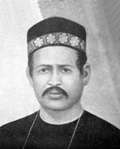Dinabandhu Mitra

Dinabandhu Mitra (Bengali: দীনবন্ধু মিত্র) (1829–1873) the Bengali dramatist, was born in 1829 at village Chouberia in Gopalnagar P.S., North 24 Parganas and was the son of Kalachand Mitra. His given name was Gandharva Narayan, but he changed it to Dinabandhu Mitra.
Early life
Dinabandhu Mitra's education started at a village pathshala. His father arranged a job for him on a zamindar's estate (1840). But the small boy fled to Kolkata, where he started working in the house of his uncle, Nilmani Mitra. Around 1846, he was admitted to the free school run by James Long. Dinabandhu was a bright student and won a number of scholarships. In 1850, he enrolled at Hindu College and was awarded scholarships for academic excellence. However, he did not appear in his last examination, and, instead, started working as a postmaster at Patna (1855). He served in various posts in the Postal Department in Nadia, Dhaka and Orissa. In 1870, he was made supernumerary post- master in Serampore Head Post Office- 712201 In 1872, he joined the Indian Railway as an inspector.He wrote the play called neel darpan(indigo mirror)
Literary career
Dinabandhu started writing literary pieces while still at college. His poetic style was inspired by the well-known poet Ishwar Chandra Gupta. His poems were able to attract the attention of intellectuals at kolkata, but his favourite genre was the drama. His work in the postal department had taken him to various parts of the country giving him opportunities to study human life closely and thereby adding to his ability to unfold the drama of life with a degree of realism unknown at that time. Among his books of poems are Suradhuni Kavya (first part appeared in 1871, second part appeared in 1876), Dvadash Kavita (1872). His plays include Nildarpan (1860), Nabin Tapasvini (1863), Biye Pagla Budo (1866), Sadhabar Ekadashi (1866), Lilavati (1867), Jamai Barik (1873)and Kamale Kamini (1873). He also wrote a novel titled Poda Mahehshvar. Another one of his noted contributions was the hilarious - "Jamalay-e Jibonto Manush" (An Alive man in the abode of Yama), the basic story line will later be adopted into an iconic film starring Bhanu Bandopadhyay. It has to be noted that Mitra was also a pioneer in the sense that his plays focused on humans rather than gods & goddesses. Also in Jamalay-e he involves popular Hindu gods to generate humour, which would later be done by Rajshekhar Basu too.
Nildarpan
Dinabandhu is, however, primarily known for his play about the plight of indigo farmers Nil Darpan. The Indigo Revolt (1858) or Nilbidraha in Bengali was the revolt of the indigo farmers against the indigo planters. It was just one year after the Sepoy Revolt Bengal saw one more important revolt in its history.
Mitra stormed the social and the literary circle of Bengal by his most notable play Nildarpan in the year 1860. It was published from Dhaka and soon after its publication it ignited a major argument in the newspapers.[1] His first hand experience of the indigo cultivators, while on the job as the post master in rural Orissa and Bengal, were reflected in the drama. Michael Madhusudan Dutt translated the play into English immediately after it was published .[2] and Reverend James Long published it. The Nildarpan got wide publicity in Europe where it was translated into many other languages. No other Bengali book at that time got so wide publicity at such large scale.[1] A lawsuit was filed against Rev. Long by 19 July 1861 for libeling the editor of the englishman and libeling the indigo planters. Rev. Long was fined a sum of 1000 Rs. and a month of time in jail, the fully packed court house were full with sympathy towards the Rev. and the dramatist. The fined sum was paid at the spot by another legend of Bengal Renaissance Kaliprasanna Sinha.[3] The court hearing against the indigo planters went for the next four years. Nildarpan was so emotionally motivating that when the play was staged, the notable educator and reformer Iswar Chandra Vidyasagar was so taken in by the realism of the performance of Ardhendushekhar Mustafi, the actor playing the role of the indigo planter Mr Wood that he threw a shoe at the actor. The actor accepted the shoe as a compliment.[4] Bankimchandra Chattopadhyay compared Nildarpan to Uncle Tom's Cabin for its role in arousing people's awareness of the evils of indigo plantations.[4] It played an important role in the Nilbidraha.
Later life and death
Dinabandhu was awarded the title 'Rai Bahadur' by the British government for services rendered at the Battle of Lushai. He died on 1 November 1873.
The college Dinabandhu Mahavidyalay (estd. 1947) is named after him.[5]
See also
References
- 1 2 Dinabandhu Mitra, Ajit Kumar Ghoshal, Shahitya Academy Publication
- ↑ . Prothom Alo, Sunil Ganguli, Ananda Publishers
- ↑ Dinabandhu Mitra, Ajit Kumar Ghoshal, ISBN 81-260-0546-7
- 1 2 http://en.banglapedia.org/index.php?title=Mitra,_Rai_Bahadur_Dinabandhu
- ↑ Dinabandhu Mahavidyalay History College official website. Retrieved 27 July 2012
- Dinabandhu Mitra, Ajit Kumar Ghoshal, ISBN 81-260-0546-7